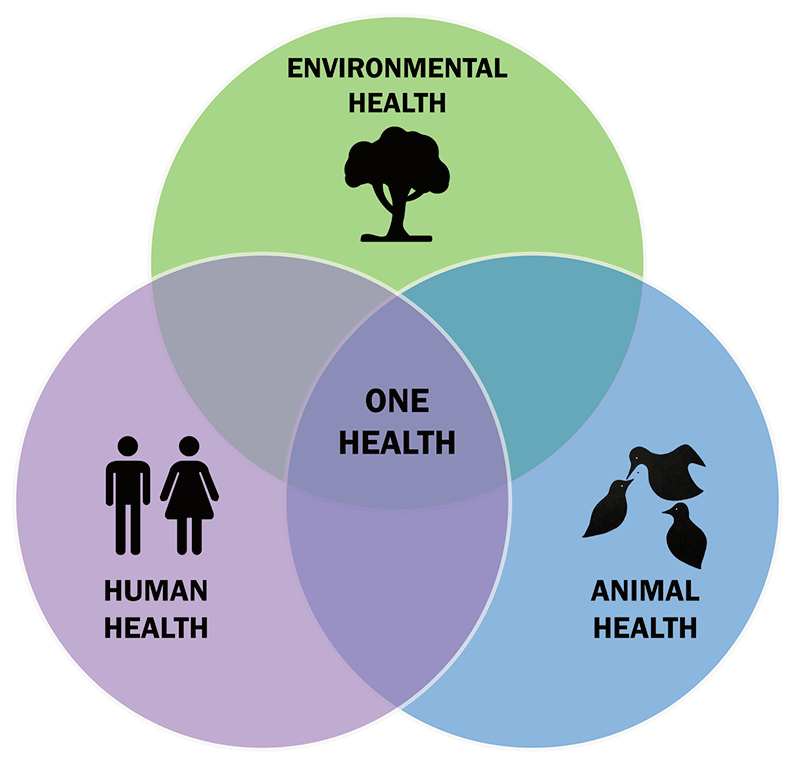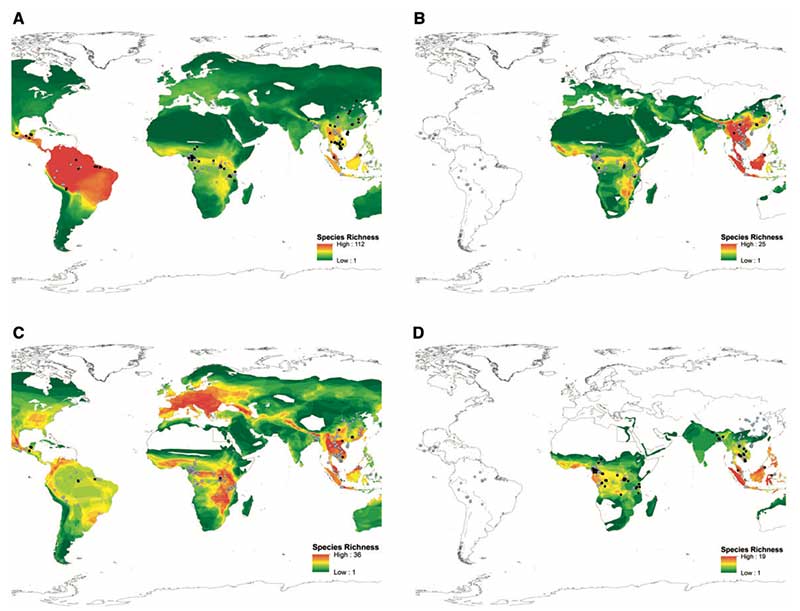Dr. Tracey Goldstein is a professor in the Department of Pathology, Microbiology, and Immunology at the UC Davis School of Veterinary Medicine. She is also Associate Director of the One Health Institute. She was recently featured in an iBiology video about the process of doing research on coronaviruses and infectious disease outbreaks, Studying Coronaviruses: Vectors to Vaccines. Our interview covered so many more questions than we were able to show in the video, so we’ve continued the conversation here. Read on to find out more about Dr. Goldstein and her work, and visit the One Health Institute online for updates. Questions and responses have been edited for clarity.

Can you tell us a little bit about One Health? What does that mean?
One Health is an approach where you try to tackle large problems by looking at them from the animal, the human, and the environmental side. When you think about what’s happening right now with the coronavirus outbreak, it’s obviously an outbreak infecting people, but it likely came from animals, and potentially that’s associated with changes in the environment. The One Health approach is a discipline where you want to look at things from the perspective of animals, people, and the environment, and see how they interconnect and how they link to changes in one another. You want to take a holistic approach when you look at these problems, and then also gather an interdisciplinary team. So involve medical doctors, virologists, veterinarians, sociologists, etc. to tackle these large problems.

How did you get into this kind of work?
Most of my career has really been working with wildlife and specifically marine mammals and trying to understand how health and disease affects their populations. But of course when you think about marine mammals, their lives are so intermingled with people. They eat fish, so suddenly you’re dealing with issues that affect fishermen and their families. I think I’ve always probably done One Health research just by definition of the work I’ve done.
And then in recent years, for the last 10 years in fact, we’ve been working on the PREDICT Project, and specifically that is looking at diseases in animals that spill over into wildlife. We’ve been really taking a One Health approach more by design for those projects where we make sure that we sample animals, people, and the environment to understand the changes that are occurring.
You mentioned the PREDICT Project. What is that?
Yeah, so the PREDICT Project has been funded by the US Agency for International Development (USAID) for the last 10 years, and we’ve been working primarily in Africa and Asia. They were really forward-thinking. This project came about after some of the large avian influenza outbreaks, and what [USAID] realized was that they’ve been doing surveillance on the human side and domestic animal side, but really wildlife was not a part of that equation, and that many of these diseases that cause pandemics come from wildlife. And so they wanted to bring that into the equation, and we were lucky enough to win that project. For the last 10 years, we’ve been sampling animals and then domestic animals and people and trying to understand the viruses the animals have and what might lead to spillover into people.
In addition to primates, you talked about focusing your sampling on bats, and rodents. Why is there this association between infectious disease and these animals?
Yeah, such a good question. Certainly history shows us that many viruses have spilled over from rodents and from bats. Arenaviruses, things like Lassa fever have come from rodents. Then in more recent years, we’re learning things like coronaviruses are coming from bats. Why is it that they have all these viruses? I don’t know that we know the answer to that, but when we think about the coronaviruses for example, we know of about six different coronaviruses that infect people. But when we look at bats, depending on the species we’ve been finding about five different coronaviruses in each bat species. But if you extrapolate that to the number of bat species that there are worldwide… Say, let’s say 1,200, suddenly that’s thousands of coronaviruses. So I think it’s that diversity of the bat species that also leads to this diversity of viruses.
We are trying to understand a little bit more about bats. Why is it that they can have these viruses that can be so lethal in people but don’t seem to affect them? And we don’t really know that. We think it’s something to do with their immune system and other physiological factors that we don’t yet understand. Also, in terms of contact, they live very closely with us. In our homes, they’re in the fields, they share the food we eat. Bats will pollinate crops and fruits and all those things, so I think they live really, really closely with us. The opportunity for contact is really high.

What else have you found about the association between coronaviruses and bats?
Yeah, like I was saying before, when we were doing our sampling, we found that we could find up to five coronaviruses in one bat species. What that means is that where you find more bats, you probably find more coronaviruses. There’s certainly that relationship there. The other thing though that we did is we wanted to see what were the sample types that we were finding these viruses in? Because that of course explains how spillover may occur.
We did some studies looking at the different sample types, and were they more likely to be found in oral swabs versus rectal swabs, etc. And in fact we found the majority of them were really found in feces. That’s really important when you think about exposure of bats in your houses urinating or defecating on things. And then oral swabs for some of them. So again, that means if you get bitten by an animal, you might be exposed to a different type of virus.
So I think it’s the combination of where these animals live and then what sample type you might find the virus in that can talk about how transmission could occur. That’s of course important because it’s sort of thinking about how you might mitigate these and protect people from exposure.
With all the talk about bats and disease, do you ever worry about bats being villainized?
Yeah, I think it’s really an important point and question. One of the things we always try to do is have a balanced approach, and make sure that people understand, number one, these animals play important, really important ecosystem roles. Think about insectivorous bats. Without them, crops would be heavily affected by insects. Without the fruit bats who are pollinators, crops and fruit orchards wouldn’t even be pollinated. So they play hugely, hugely important ecosystem roles. If you decrease a population, there’s going to be a lot of unintended consequences on the ecosystem side in terms of pollination, and more insects could possibly even increase exposure to things like malaria.
But then on the animal side, [killing bats] actually doesn’t really solve your problem. There’s been some great work by the CDC looking at Marburg virus. When they found that virus in a cave in Uganda, the first thing people wanted to do was go into the cave and kill all the bats. That actually resulted in more viral shedding versus less viral shedding because a population’s response to a lot of animals being killed is to make more animals. So there was an increase in the birth pools, and then many more susceptible animals, which resulted in even more infectious animals shedding virus. And so they actually had the opposite effect by killing the animals than what they would have thought. I think both from the animal point of view and then from the ecosystem point of view, really, really important to conserve these animals, and they play a really important role in the ecosystem and in keeping us healthy.
We have a campaign that’s called Living Safely with Bats that the PREDICT Project developed, and we specifically at the time developed it because of a virus we found in Sierra Leone, and we’ve been working now in about 30 countries and going into the communities and talking about how to recognize when bats are in their homes and then how to protect themselves. This includes covering water sources, moving livestock away from places where bats roost, and keeping children from playing under bat roosts. Sort of trying to teach people how to live safely versus trying to kill them, which is not really a successful strategy anyway.
Do you have any thoughts or advice to students and early-career scientists in terms of what to study, what to think about, or other things you see on the horizon?
Yeah, there’s a few areas that come to mind right now. For example, understanding the immunology of these animals. We know almost nothing about bat immune systems. So if there are students right now with that interest, they’re poised to do some really, really important work that will be very informative for the future. Also, getting skills to do modeling and data analysis, and develop new methods for that. When we’re dealing with that global coronavirus data set, there weren’t really good methods for us to understand the ecology of viruses and bats. We had to borrow, of course, from other fields, and so you need people that can take models that have been developed for other purposes, and then tweak them for new needs. That is another huge interest. And then bioinformatics. If you’re interested in trying to understand genomes and sequences and hosts and all of that and develop new methods to be able to analyze those data, that’s another huge need.
The other thing that’s really missing is working closely with sociologists that understand the type of work that we do and how to then translate health and disease information back into the communities to change behavior. That’s really complicated work. We definitely work with sociologists, but I think we speak different languages. So trying to come up with a more multidisciplinary way to approach those problems would be something else that would be interesting. So I think students from all different walks of life or areas of interest definitely have a role to play in the future.





Leave a Reply